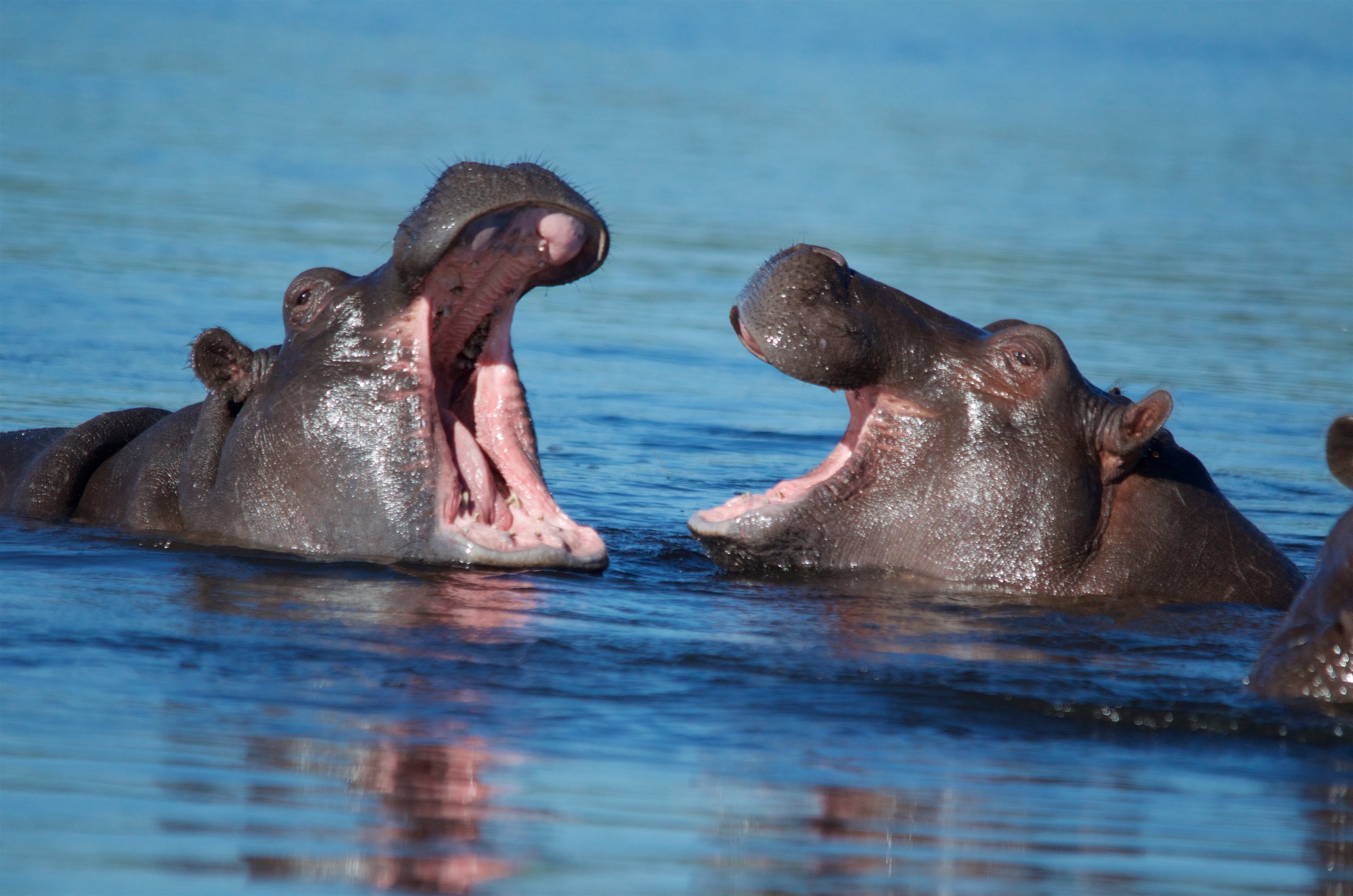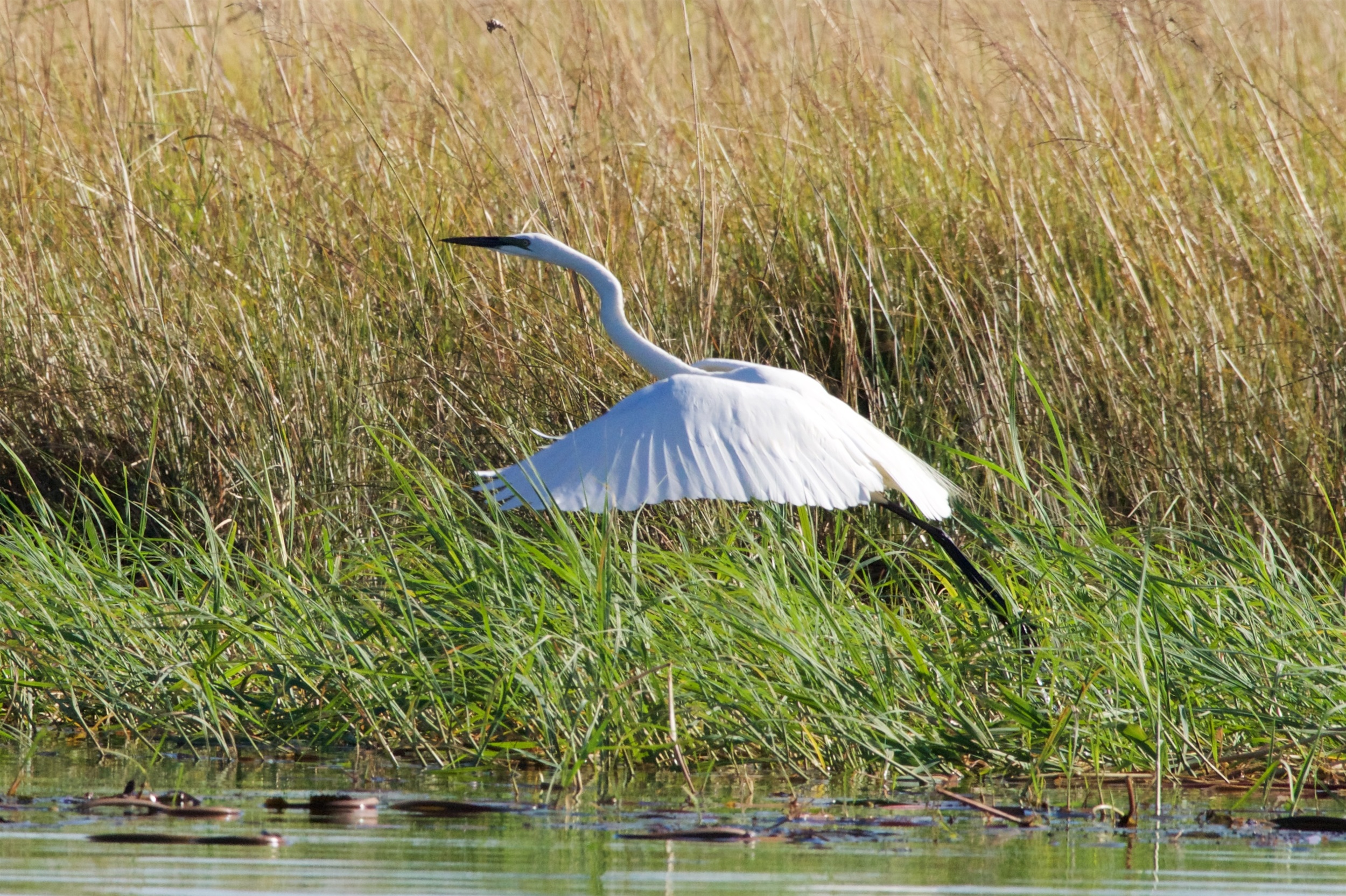A spectacular pink coloured pre-dawn sky together with a crescent new moon greeted us heralding in another glorious Botswanan day. Since we’ve been here there’s not been a single cloud in the sky and each day reaches a very pleasant temperature in the mid to high twenties.
We were out on the water at 0630 and with there being not a breath of wind, the river was mirror calm with reflections abounding in all directions.
At the end of the wet season in April/May, the Chobe River stretches to be over a kilometre wide in the National Park region. With the onset of the dry period the water level slowly drops and what is presently a vast flood plane becomes a meandering group of smaller rivers with Namibia on the northern bank and Botswana to the south.
Our first point of interest was at the reed bank in the middle of the river to once again see and photograph the green little bee-eaters. These beautiful birds are clearly not frightened of humans or boats as we were able to get within a metre of them without them taking flight. These small bee-eaters tend to congregate on the same reed stems each dawn. The biggest group we saw this morning was one of seven birds.
Little bee-eaters
There were numerous sightings of birds including fish eagles, pied kingfishers, cormorants, lapwings, helmeted guinea fowl, Egyptian geese, ducks, darters, wire tailed swallows, water thick-knees and African jacanas.
Wire-tailed swallow
We caught fleeting glimpses of malachite kingfishers but they were either too distant or timid to tolerate close encounters. However, very luckily, using the 500mm lenses together with the boat’s stabilising platforms we were still able to get sharp images of these and other distant birds.
We managed to get very close to a juvenile green backed heron although this shy bird stayed partly obscured behind some bushes.
Wandering along the river’s bank was a red lechwe and then a much larger waterbuck. The red lechwe antelope is similar to an impala although it is immediately recognisable by the short front legs compared to the back legs. The water buck is a heavy build antelope with a distinctive white circle around its tail area.
Water buck
It was at this point that we first saw a lilac roller. This stunningly attractive bird is multicoloured with a lilac breast, sky blue body and a long blackish forked tail.
Although quite common they tend to perch high in dead trees or on power lines making them quite tricky to photograph. They fly from tree to tree with a swooping action that is quite distinctive.
Lilac roller
We then pulled into the riverbank for some mid-morning drinks and biscuits and had an extended encounter with a largish (3m) crocodile that was sunning itself on the warm sand. The danger of these reptiles was illustrated by the fact that without warning this utterly immobile creature suddenly swung around and within seconds had entered the water and was gone. Similarly a shy African swamphen was sighted for a fleeting glimpse and then disappeared into the reeds. We also saw two Burchells coucals which where partially hidden in the top of bushes. These birds are uncommon in this locale.
Kudu
We were then fortunate to have a large male kudu stroll down the water’s edge for a drink. We were able to get very close to this magnificent animal and observe the huge antlers and its incredibly muscular neck. He was drinking for some five or so minutes and then as if he’d detected the odour or a potential predator he became agitated and headed off into the protection of the nearby cover.
Impalas on the Chobe River bank
As was the case yesterday, antelope especially impalas are a common sighting as are water buffaloes and hippopotamuses. One group of hippos entertained us with some playful interaction between semi-adult (males?). This entailed contested gaping mouth displays and head pushing which seemed to be utterly ignored by the much larger adult hippos that were seemingly asleep or disinterested. One large hippo stood partly submerged the whole time with two blacksmith lapwings and a pied kingfisher on its back.
Hippos
Hippos
Prior to heading back to Kasane for our ‘brunch’ we spent a few minutes photographing a great egret which stands over one metre tall even with its elegantly curved neck. Whilst photographing this beautiful snow white bird we saw two African pygmy geese swimming amongst some hippos. Strangely these are actually tiny ducks with prominent orange breasts and flanks. Being quite shy, they moved away to hide as soon as we approached.
Great egret
Great egret
Great egret
The afternoon to dusk session on the river proved once again to have a number of stunning moments.
Jak with Gimpro camera mount
Chobe National Park registration office
Initially we came upon an adult green backed heron and then a juvenile which was much happier about our presence than the one we’d seen this morning.
White-crowned lapwing
Then Shar, our highly observant boat driver spotted a giant kingfisher sitting high in a tree on the water’s edge. These are the largest of the kingfishers and have massive beak and a black and white spotted body with a chestnut coloured band across the breast.
Giant kingfisher
White-fronted bee-eater
Once again we encountered lilac rollers but the one we could get closest to was partly obscured by a branch so only the upper body and tail were clearly visible. The incredible number and diversity of waterfowl on this flood plane is hard to comprehend even the different species of ducks makes identifying each type quite problematic.
Elephant & calf
Elephant drinking
A large crocodile of size approaching 4m in length was then seen luxuriating in the bright sunshine very close to the water’s edge. Based on the experiences of yesterday and the croc’s speed of attack we immediately recognised the potential danger for any creature that was to venture close by.
Crocodile
Although we’d had very limited success this morning we were now fortunate to get close to four African pygmy geese. These shy birds stayed reasonably nearby enabling us to get some good photographs before they sought cover within the dense reed cover.
Hippopotamus in mud
A major highlight of the afternoon was again a consequence of Shar’s sharp vision. In amongst the reeds on the riverbank he spotted a tiny jacana chick. We waited patiently and eventually a male jacana appeared with three chicks, one of which was tiny being presumably a very recent hatchling. These gorgeous little water birds performed by strutting back and forth across the waterlily leaves under the close attention of their father. The male jacana is the principal parent in the upbringing of their young.
A large gathering of kudu that came down to the river to drink gave us an extended opportunity for getting close-up shots of these attractive antelopes.
With the sun sinking towards the horizon we encountered six African open-bill storks. These are large black storks with frilly black breast feathers and a gap between the mandibles of their bill. They were fossicking for snails and other creatures in the muddy wetlands and they formed ideal silhouettes against the setting sun. After some further sunset shots we ventured home and then decided to have a buffet dinner at the nearby Chobe Lodge.
This was another cracker of a day with unbelievably good weather and a myriad of things to see and appreciate. This safari adventure leaves nothing to be desired.




















